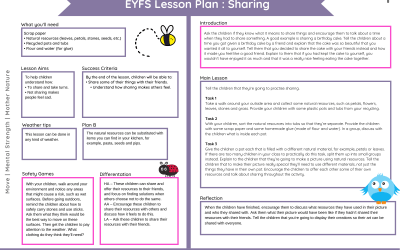World tiger day EYFS is a very important day to raise awareness of the beautiful animal that is the tiger. ...
Filling up a Wellbeing Bucket (Early Years Outdoors)
Dec 7, 2020
Filling up a wellbeing bucket could not be more perfect for The Muddy Puddle Teachers. We are all about wellbeing and...
Parachute Games (Numbers)
Dec 5, 2020
The Benefits and Advantages of Parachute Games in Schools Parachute games have become a staple in physical education...
*FREE*Upcycled Role Play – Tots
Dec 4, 2020
Use Upcycled Role Play - Tots to help add some drama into your provisions. Upcycling teaches children how to respect...
Teaching social skills outdoors
Dec 3, 2020
Use Teaching social skills outdoors ideas pack to help children learn and master social skills in natural...
Crafting with upcycled materials
Dec 2, 2020
Use Crafting with upcycled materials to appreciate the joys and creativity that can be gained from your junk. It is a...
Muddy Elf (Nursery&School Pack)
Nov 30, 2020
Use this incredibly innovative and creative Muddy Elf Ideas Pack to get your children outside daily to enjoy an Elf...
*FREE*Outdoor Mark Making Lesson Plan
Nov 5, 2020
Use Outdoor Mark Making Lesson Plan to engage children with the very important phase of using their hands to make...
Phase One Aspect 1/2/3
Nov 3, 2020
Use Phase One Aspect 1/2/3 to teach the first three aspect of this very important phase and of course it is done using the Muddy Puddle way!
*FREE*First day back Lesson Plan
Oct 23, 2020
Use First day back Lesson Plan to settle your children back in the Muddy Way and to focus on friendship.
Horrible Halloween Lesson Ideas Pack
Oct 22, 2020
Use our Horrible Halloween Ideas Pack to get lots of ideas and ways to make Halloween special in your class.
Halloween Trick or Treat Lesson Plan
Oct 22, 2020
Use Halloween Trick or Treat Lesson Plan to get role play, speech and language into one outdoor learning lesson!
*FREE*Sharing Lesson Plan
Oct 22, 2020
Use Sharing Lesson Plans to get the best out of your class in an active, natural way.
Isolation Packs for Early Years
Sep 21, 2020
Use this fabulous Isolation Packs for Early Years to help parents educate at home. Educating at home the muddy way means happy memories for all!
10 minute active games tots
Sep 18, 2020
Have 10 minute active games – Tots handy by your side so you can have some active and muddy games to keep those little ones busy and happy.
One more than 20 – Under the Sea
Sep 18, 2020
Use this amazing eBook One more than 20 – Under the Sea to practice your number knowledge the muddy way!
Junk Modelling
Sep 17, 2020
Junk modelling is a great way to enthuse creativeness and gather up unused items to put to another purpose. Outdoor Learning
Indoor Planting
Sep 17, 2020
Make planting a little easier for yourself by taking some of it indoors. This delightful pack offers ideas for vegtables, fruit, flowers and herbs.
New In

24 Nature Crafts for Advent

KS3 Outdoor Art Ideas Pack

Fractions KS1 Ideas Pack

Craft Ideas for Babies in Autumn

Adjectives in Autumn KS1

My Senses in Autumn (KS1)

Parachute Games Knowledge and Understanding of the World

25 Parachute Games (PSED)

Lanyard Challenges Sand Area (Underwater Theme)




















